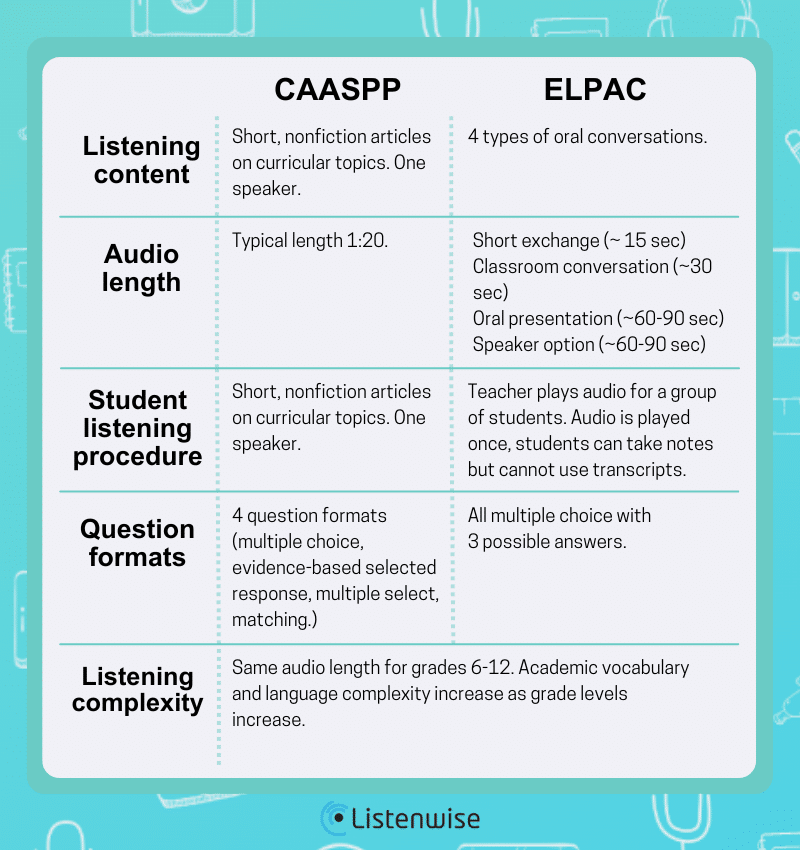Last Updated on March 19, 2025
Preparing students for the CAASPP and ELPAC, like so many exams, is not just about teaching the content. Practicing how to take the exam is equally important. Making sure that students have regular practice with content delivered in a format similar to what they will encounter on the tests is crucial. However, finding suitable materials to provide that exposure for students is time-consuming.
Listenwise’s ELD Lesson Library has multiple podcast and video lessons that can be used as ready-made practice tests for students.
We hope that this blog will provide helpful resources for California educators whose students are tested on their listening skills through the English learner assessment called the ELPAC and within the ELA portion of CAASPP.
What are the CAASPP and ELPAC?

The California Assessment of Student Performance and Progress (CAASPP) test serves as a vital tool for evaluating and enhancing student learning outcomes. The test results offer a detailed snapshot of each student’s academic performance, highlighting areas of strength and weakness.
Similarly, the English Language Proficiency Assessments for California (ELPAC) is a tool that provides insight into each student’s English language abilities, identifying the unique linguistic needs of each individual.
CAASPP vs. ELPAC: How They Compare
The two most significant differences between the assessments are the type of audio that is listened to and the listening procedures. Though both the CAASPP and ELPAC assess listening comprehension, each exam goes about it differently.
The two most significant differences between the assessments are the type of audio that is listened to and the listening procedures. CAASPP listening passages are short informational texts read aloud by one speaker. The passages are typically related to common grade-level curriculum topics. Listen to a sample audio passage from CAASPP 5th grade (about 1½ minutes long) about asteroids and space.
Watch this short testimonial where a teacher from Vista USD explains how she uses Listenwise to prepare her students for the ELPAC.
In contrast, the ELPAC listening segments are conversations, more similar to spoken English that a student would encounter in the classroom. There are four different types of listening segments that range in length and complexity (see chart below). The ELPAC practice tests do not provide the audio files, only transcripts of the conversations.
The “oral presentation” type of question on the ELPAC is most similar to the CAASPP, as it features a teacher talking about a curriculum topic. All the other ELPAC listening tasks feature two different speakers.
The other significant difference in the tests is in how the students listen. In the CAASPP, students can each listen to the streamed audio individually and replay the audio as desired, using an embedded notepad to take notes as they listen. However, ELPAC audio will be played only one time for a group of students being tested. The ELPAC instructions do encourage students to take notes on paper while listening to the longer segments which are similar in length to the CAASPP items.

Preparing for CAASPP and ELPAC Using Listenwise
Certainly having students practice listening to audio related to curriculum topics can help students prepare for both the CAASPP and the oral presentation and speaker opinion task types on the ELPAC. Also, audio dialogue that discusses opinions and points of view on a current topic is very useful, especially for ELPAC.
Using Listenwise, teachers can assess student listening comprehension with formative quizzes or have students practice note-taking with organizers and short response questions.
To begin, students will benefit from supported access to challenging content, such as being able to read the transcript as they listen or look up unfamiliar words. However, teachers can hide the transcript when they want to more closely model the tests. For teachers with students taking the ELPAC, some practice should also be given with audio stories played once from the front of the classroom, not just students listening on their own.
Ready to start preparing your students for the CAASPP and ELPAC? Take a look at the three podcast and video lessons listed below for examples of Listenwise content that resembles the format and objectives they will encounter during their test.
3 Listenwise Lessons to Prep for CA State Testing
Bird Mystery (ELD)
Populations of migrating birds have declined sharply, and scientists are trying to figure out why. This audio story features an interview with a biologist and bird expert about how and why scientists are tracking migratory birds and what people can do to help them. Listen to hear about how tagging birds with radio transmitters can help wildlife biologists understand their behavior and discover why migratory birds are disappearing.
Content Objective: Students will be able to demonstrate an understanding of how and why scientists track migrating birds.
Why Use This Lesson: This podcast provides a good opportunity for students to practice listening to a conversation between two speakers like they will hear during the ELPAC. In this podcast, the conversation is between a host (Emma) and an expert (Dr. Bridget Stutchbury), which approximates the quality of the “classroom conversations” that will be played for students during their exam.
The Olympic Games (ELD)
The first Olympic games were held in Greece over 2,500 years ago. They were part of a festival honoring the Greek god Zeus and featured just one event, a 600-foot race. The Olympics have changed greatly since that first event. Today’s Olympics take place every two years and bring together athletes from around the world to compete in hundreds of sporting events. Listen to learn about the ancient roots of the Olympics and the symbols and traditions that make the Olympics unique.
Content Objective: Students will be able to demonstrate an understanding of how the Olympic Games began and how they have changed over time.
Why Use This Lesson: Both the CAASPP and the ELPAC have sections where students will be asked to listen to a short oral presentation by a single narrator. The content will be a curricular topic, often related to science or history. This podcast lesson features a single narrator speaking on a history topic in a slow, deliberate manner. Assigning this lesson to students provides them with an opportunity to practice their listening skills in a way that closely mirrors the CAASPP and ELPAC.
Hearing But Deaf (ELD)
Some people who are deaf use assistive technology such as hearing aids or cochlear implants to help them hear. Others feel that using assistive technology impacts a deaf person’s identity. One teenager who was born deaf has had cochlear implants since she was a year old, enabling her to hear and speak. As a result, she has felt excluded by members of both the hearing and the Deaf communities. Listen to her reflections on her experience navigating both worlds as someone who is “hearing but deaf.”
Content Objective: Students will be able to demonstrate an understanding of one girl’s experiences living with cochlear implants.
Why Use This Lesson: During the ELPAC exam, students will be asked to listen to a presentation of a speaker’s opinion. This podcast lesson features a speaker (Juliet Corwin) sharing her experiences living as a Deaf teen with cochlear implants. Students listening to this story will gain experience with listening to a speaker state their opinion and explain reasons to support their view.




